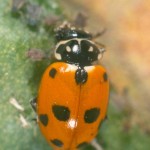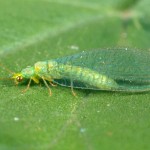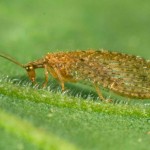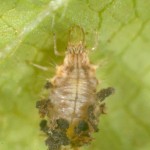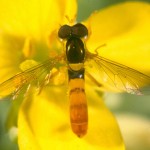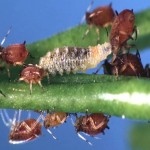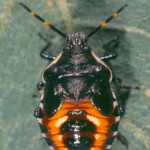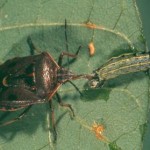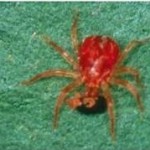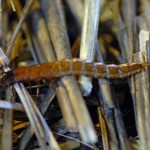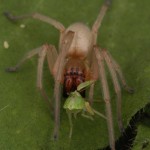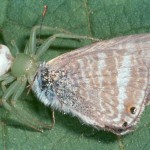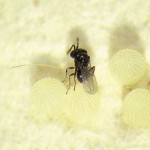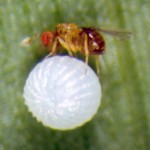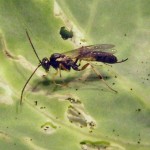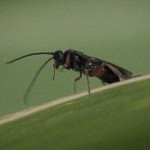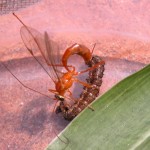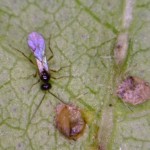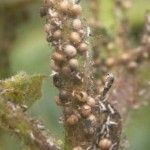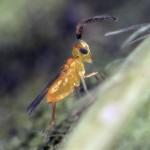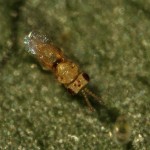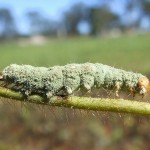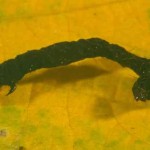Factoring in the contribution, or potential contribution, of beneficial insects to a management decision is not easy. Identifying which ones might have an impact on the pests in that crop, and estimating how much impact they might have is important when determining whether beneficials are likely to suppress the pest population below threshold, or whether you will need to treat the pest infestation to prevent crop loss.
Whilst there is some knowledge about beneficial insects prey preferences and consumption, there has been little research to quantify the potential impact on pest populations under field conditions, and no official predator:prey ratios available to guide management decisions.
It is possible to monitor the presence and activity of some beneficial species, particularly larger predators and some parasitoids. Beneficial species that are very small, are active at night, or dwell below ground, can be difficult to monitor. The following are some indicators of key beneficial insect activity in crops:
Predators
|
Pathogen |
Pests attacked |
Look for |
|---|---|---|
| Ladybirds (several species)
|
Adults and juveniles attack a range of insects in crops, including aphids, moth eggs and small larvae, mites, whitefly nymphs, mealybug, and scale. Feeding preferences are currently not well understood. | Adults, eggs and larvae in close association with infestations of the pests. An increase in ladybird numbers, and corresponding decrease in prey numbers is indicative of impact on pests. |
Lacewings (Brown and Green)
|
Juveniles will attack a wide range of prey including aphids, small caterpillars, eggs, thrips, mites.
Adult lacewings are not predacious (they eat pollen, nectar and honeydew). |
Adult lacewings are often visible in crops, and collected in sweepnet samples. The eggs of the green lacewing are distinctive (white eggs on long slender stalks). Larvae are found in association with aphid colonies and other pest infestations. |
| Hoverflies
|
Larvae are aphid predators. | Can be difficult to see, particularly in the early instars. Usually found amongst dense aphid infestations. Larvae leave aphid skins once they have fed, although these are difficult to distinguish from the shed skins of moulting aphids. |
Predatory bugs
|
Both adults and nymphs predate soft-bodied insects and eggs. Prey include caterpillars and eggs, mites, and aphids. | Adults and nymphs can be found on the beat sheet and in sweep net samples. Little evidence of predatory bug activity is visible in the field. |
Predatory mites
|
Predators of earth mites and lucerne flea. | Found in the same environment as earth mites and lucerne flea (weeds, pasture, establishing crops). |
| Predatory earwig – Common brown earwig (Labidura truncata)
|
Predator of a range of soft-bodied insects including mites and caterpillars. | Largely nocturnal (active at night). Shelter and pitfall traps may be useful in assessing their abundance in a paddock. |
| Ground Beetles (Carabids) – Numerous species – most predacious to some extent
|
Both adult beetles and larvae are predators, feeding on caterpillars, aphids, lucerne flea, mites, earwigs, slugs, snails, and beetles. Soil-dwelling carabid larvae may attack some soil insect pests e.g. cockchafers. | Largely nocturnal (active at night). Shelter and pitfall traps may be useful in assessing their abundance in a paddock. |
| Spiders
|
Spiders are hugely varied in the prey they target, and the way in which they capture them. Free-living species, web spinners, burrow dwelling, ambush and stalking species are all active in agricultural landscapes. Their prey include almost all pest and non-pest invertebrates that inhabit crops. Adult and juvenile spiders are similar in appearance, differing in size. | Web-building species are often the most obvious in crops. Other species will be collected in beat sheet or sweep net sampling, or observed during visual inspections. Like most other predators, there is little direct evidence of spider activity. However, the absence of spiders in a crop is an indication of a disrupted system. |
Parasitoids
|
Parasitoid |
Pests attacked |
Look for |
|---|---|---|
Egg parasitoids of caterpillar pests (helicoverpa, armyworm, diamondback moth)
|
Parasitoid wasps lay eggs into the newly laid eggs of caterpillar pests. The developing caterpillar is killed, and a wasp emerges from the egg. | Not easily seen in the field. Eggs may appear black (rather than the usual white or brown ring). Wasp activity can be monitored by collecting eggs from the field and determining the proportion parasitised. Over time, repeat collections provide a useful guide to the likely impact on the pest population. |
Caterpillar parasitoids of Helicoverpa, armyworm, cutworm
and diamondback moth
|
Parasitoid wasps lay eggs into larvae or pupae of caterpillar pests. The caterpillar may be killed prior to, or during pupation. | Medium-large wasps/flies can be seen actively seeking out larvae in crops.
|
Aphid parasitoids
|
Aphid parasitoids are specific to aphids, or to a particular species of aphids. The wasps will lay eggs in both small and large aphids, depending on availability. | Mummies are characteristic of aphid parasitoid activity. Look for brown, bloated aphid mummies amongst aphid colonies. From ‘sting’ to mummy takes about 10 days. Recording the relative number of mummies and live aphids can provide an indication of the impact the parasitoids are having on the aphid infestation. The small wasps may be visible, in close proximity to aphid colonies. |
Whitefly parasitoids
|
These tiny wasps parasitise whitefly nymphs. | Difficult to see in the field. Parasitised nymphs, and the species of parasitoid can be identified with a handlens. The level (%) of parasitism can be determined by collecting infested leaves and assessing parasitism.
A resource sheet on recognising parasitism is available from the Beatsheet website (2MB pdf) |
Pathogens
|
Pathogen |
Pests attacked |
Look for |
|---|---|---|
| Nucleopolyhedrovirus (NPV)
|
A viral disease of helicoverpa caterpillars that occurs naturally in the Australian environment | Diseased larvae typically climb to the top of the plant to die. Shortly after death, the body becomes flaccid and its skin ruptures, releasing millions of infectious virus particles back into the environment. When larval numbers are high, waves of natural infection can develop as more larvae become infected, die, and spread the infection, resulting in an outbreak. |
| Fungi
Includes Beauveria, Metarhizium, Hirsutella,
|
A variety of insects attacked including aphids, locusts, caterpillars, mirids | Fungal spores germinate and hyphae penetrate the insect skin (cuticle), often releasing toxins. Fungus grows in insect body – causing insect to die. |
| Bacteria
The best known bacterial control is Bacillus thuringiensis (Bt)
|
Used for the control of caterpillar pests. Some strains are also active against some beetles and mosquito larvae | The Bt bacteria produce highly toxic protein which when ingested by the caterpillar attacks the gut wall, causing holes in the gut and the insect stops feeding. The bacterial spores then leak through the gut wall and cause a bacterial infection. Bt causes larva to stop feeding, become immobile and death occurs within 3-4 days due to infection or starvation. Larvae turn black and shrivel up. Bt does not spread in the larval population. |
